Lily: species, varieties, planting and care
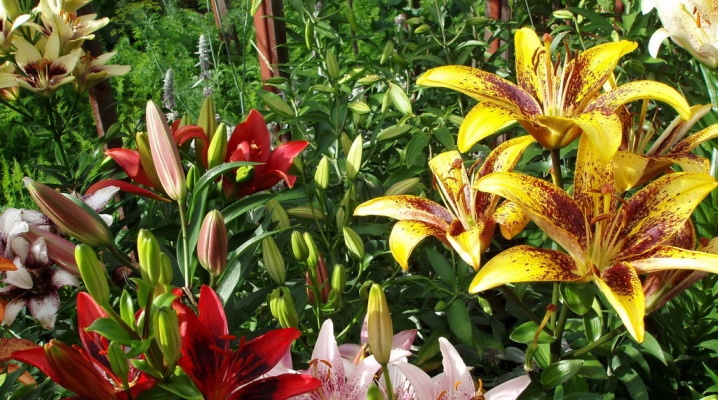
Lily is one of the most beautiful flowers, very often used for making bouquets. Despite the fact that you can always find it in a florist shop, it is much more interesting and useful to grow a crop yourself, experimenting with different varieties and enjoying the attractive view of your garden plot.

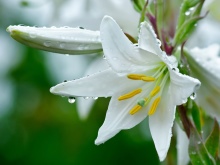

Peculiarities
Lily is a plant characterized by the presence of a bulb that looks like a short stem connected to several closing scales. The latter, in fact, are modified fleshy leaves, painted in a white, yellow or pink hue. The lily stem is simple or slightly branched. It grows from 15 centimeters to 2.5 meters, depending on the type of flower. The leaves have sturdy petioles and large egg-shaped plates. In the corner of the last lower leaf, a bud is formed, which eventually transforms into a full-fledged bulb that blooms the next year.



The flower itself is formed from six petals, usually connected in the form of a funnel or bell. The glandular tissue of the bud secretes sap, which in turn attracts insects. The capsule fruit forms a sufficient number of flat seeds of a brown shade or simply pale. It should also be mentioned that lilies can be cross-pollinated and can change color.
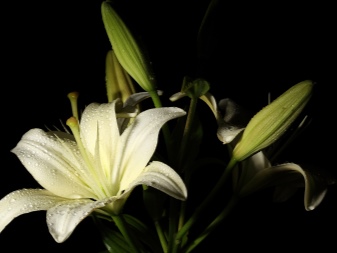
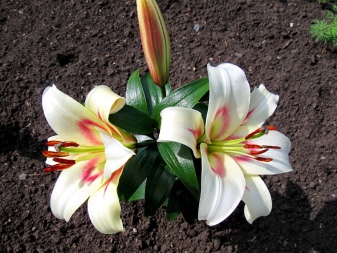
Returning to the lily bulb, its scales can be of different shapes and sizes. They build up during the summer months, and also gradually die off. The size of the flakes ranges from the size of an oat grain to almost 10 centimeters in diameter. As a rule, the number of formations does not go beyond the boundaries of the interval of 8-40 pieces, although in some cases they go beyond the mark of 120 pieces. The structure of the lily bulb can be different: stolonal, rhizome, concentric or false-columnar. Depending on the type, the color of the formation also changes.
The root system emerges from the bottom of the bulb. In most cases, the roots are perennial, although annual roots are also found. The lily grows successfully just with the help of the roots, as they help it not only to stay in the ground, but also to deliver nutrients. Some lilies have stem roots that allow them to consume moisture and nutrients from the surface of the earth, as well as keep the stem upright.
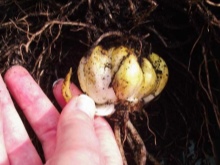


Varieties
Thanks to the efforts of breeders, the common lily has a large number of varieties, combined into several groups. Asian hybrids combine almost 5 thousand varieties of lilies, which is the maximum. Their height varies from 40 centimeters to one and a half meters. Plants are highly resistant to low temperatures and insects. Quite large buds reach a diameter of 10 to 14 centimeters when opened, and the color varies from shining white to almost black.
Flowering of Asian hybrids begins in the last week of June and ends in the first week of August. This group includes such varieties as "Aaron", "Nove Cento", "Mapira", "Lion Heart" and others.
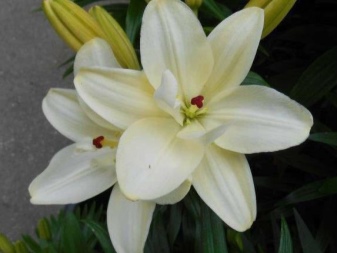
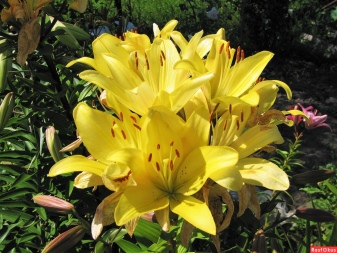
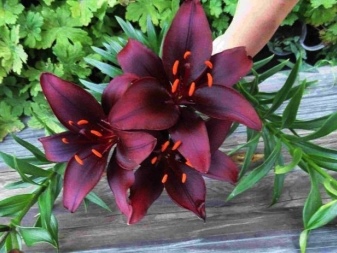
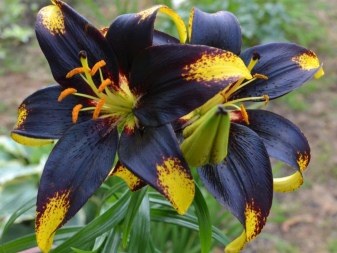
Unusual varieties in the amount of two hundred lilies are combined into a group of curly hybrids.Their height reaches almost one and a half meters, and the diameter of the flowers ranges from 5 to 8 centimeters. These varieties prefer shady, but not too dark areas, such as orchards. Such lilies do not tolerate transplants well, but they are distinguished by good frost resistance. There are dark spots on the perianth, and it itself can be white, pink, orange-yellow, dark red or lavender. Kinky varieties include such varieties as "Chameleon", "Maroon King", "Guinea Gold" and others.



White lily hybrids are also called European hybrids. As you might guess, they are all united by a common color - either white or cream. The open bud is 10 to 12 centimeters in diameter, and the stem reaches 180 centimeters. This variety is very demanding and picky about care, in addition, it does not tolerate low temperatures and often suffers from fungal diseases. The best varieties of snow-white hybrids are "Apollo" and "Madonna".
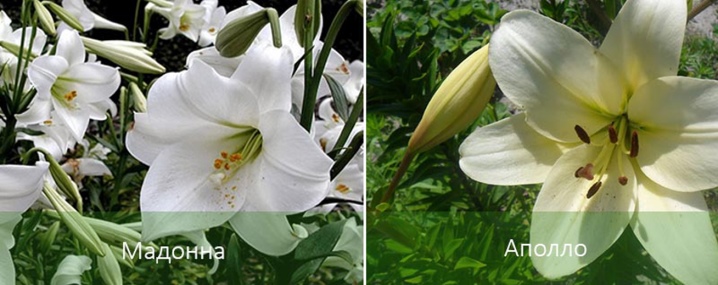
American hybrids of lilies reach a height of about 2 meters. They bloom in July with flowers with a diameter of 10 to 12 centimeters, which are painted in two shades and are decorated with large specks. Flowers thrive best in shady areas and do not respond well to transplanting. This group includes the varieties "Shaksan", "Buttercup", "Afterglow" or "Lake Tular". Long-colored hybrids in height reach from one meter to 1.2 meters, and the bell flower itself can reach from 15 to 20 centimeters.
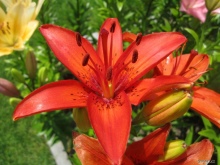
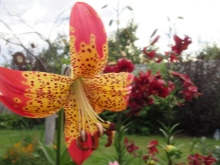
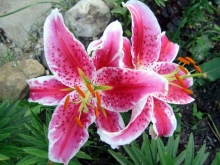
The main shade of American hybrids is pure white. Flowers do not tolerate frost well. Popular varieties of this group are White Fox, White Haven and others. Tubular and Orleans hybrids combine more than a thousand varieties. Depending on the shape of the bud, they are divided into cupped, tubular, drooping or star-shaped. The colors can be very different, and the plant height ranges from 120 to 190 centimeters. The buds themselves correspond to 12-18 centimeters in length. The varieties of this group include "African Queen", "Lady Alice", "Royal Gold" and "Pink Perfection".
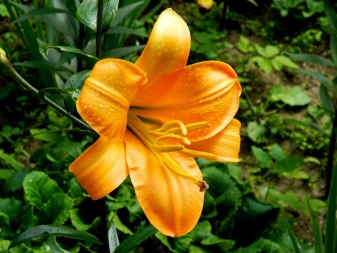
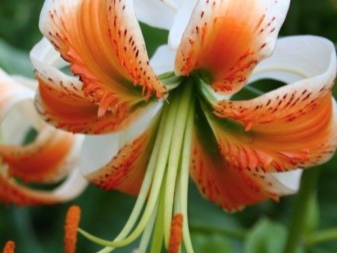

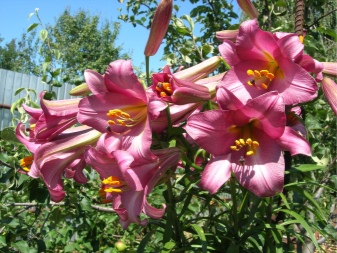
Oriental lily hybrids are considered quite whimsical and require warmth. Plant height ranges from 40 centimeters to 1.2 meters. Huge flowers, reaching a diameter of 30 centimeters, have white, pink or red petals with edging or a central stripe. They bloom from August to September. This group includes the varieties "Casa Blanca", "Le Rev", "Tarden Party" and "Stargazer". Experts also identify a group of interspecific hybrids that are not included in all of the above sections. In addition, there are species lilies and even rare hybrids.

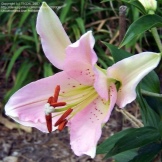
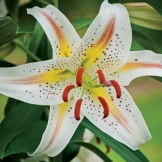

For garden plots, the Japanese lily with a beautiful pink and white color is often chosen, or the golden lily, originally from Korea. The giant lily becomes an adornment of any landscape design. It grows up to 3 meters in height, buds range in size from 16 to 18 centimeters, and large bulbs sometimes match the size of a human head. Garden lily can be cascading, bulbous or purple. In addition, wild and wild flowers, as well as a mountain lily, deserve attention.

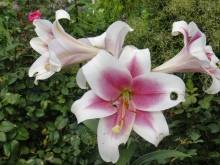

Myths about modern hybrid varieties
Lily is one of those plants whose planting material, surprisingly, is often counterfeited or becomes part of fraudulent schemes. It happens that photos are adjusted in Photoshop, after which an exotic color, for example, blue with a gold border, is passed off as a new foreign hybrid. Sometimes bags of seeds purchased from unverified sellers who call themselves intermediaries of Dutch gardeners give bloom only after a few years with faded and unattractive flowers. In order to avoid an unpleasant situation, it is necessary to carefully and deliberately approach the process of acquiring seeds or seedlings.
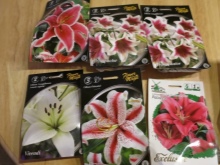

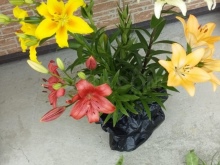
How to plant?
The correct planting of lilies in open ground largely determines not only the success of its further development, but also the absence of fungal and other diseases.



The right time
It is necessary to plant lily bulbs in the fall or spring, although in an emergency situation, the process can be carried out in the summer. Basically, spring planting is the most popular solution, since the plant has the opportunity to root, get stronger and not die during wintering... It is important to choose a time when the probability of frost return is absent, for example, in the Urals, such a period occurs in mid-May.
If you still prefer the autumn planting in September, then the root system will have time to gain a foothold, but before wintering, you will have to carry out a number of additional measures.
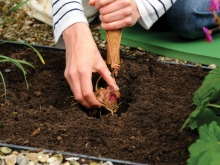

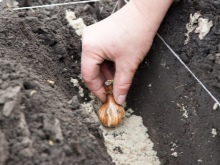
Site selection and soil preparation
The lily hole is prepared in advance. The bottom is covered with sand, after which the plant is placed inside. The site should be moderately sunny and protected from drafts. Since the lily is very demanding on the condition of the soil, it is important that the soil mixture is loose and fertile. Some varieties prefer acidic soil and some prefer alkaline soil, but most still grow in neutral soil. This issue will have to be resolved depending on the specific situation.
Approximately a couple of weeks before planting, the land is dug up with ash, peat and humus and enriched with complex mineral fertilizers. Further, the site is leveled, slammed and irrigated. By the way, the depth of the dug hole depends on the specific variety and usually ranges from 15 to 30 centimeters.
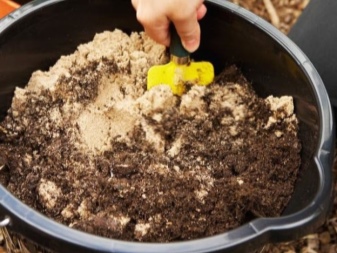
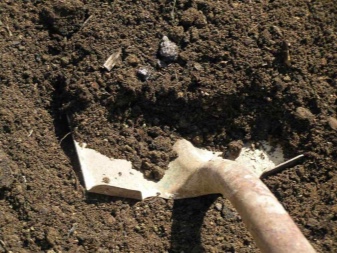
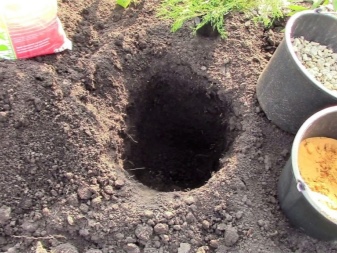
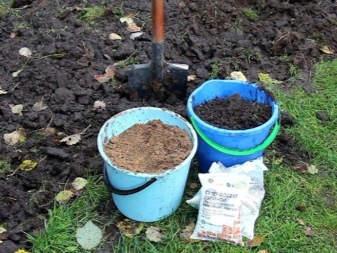
Planting material processing
Before planting, the bulbs are freed from rust-colored scales and covered with brown spots. If any part has begun to rot or other symptoms of the disease appear on it, it must be cut out. Do the same with overly long or wilted roots. The final stage of preparation is to stay for 30 minutes in a 0.2% solution of foundationol or a similar preparation.
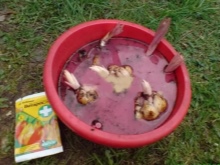
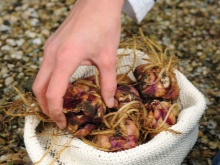
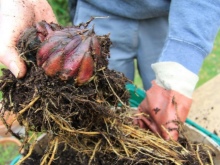
Disembarkation rules
Before planting lilies in the country, it is necessary to prepare a hole and form a drainage layer. Further, there is an onion inside, the roots of which are neatly straightened, and on top everything is again sprinkled with sand. The top layer is formed from enriched soil, which is abundantly irrigated upon completion. It is important to remember that if you place the tubers too deep, then the lily will bloom later, but in larger quantities. At the beginning of autumn, such a plant can be successfully transplanted to a new place and even propagated. In this case, the seedlings are dug out with a pitchfork, the roots are washed and cut to a 10-centimeter length, and the young shoots are slightly kept in a solution of potassium permanganate.

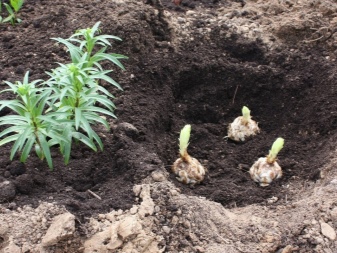
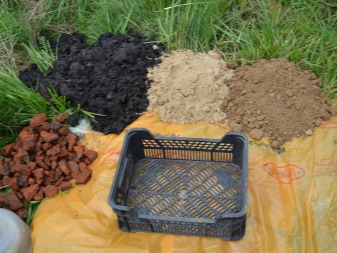
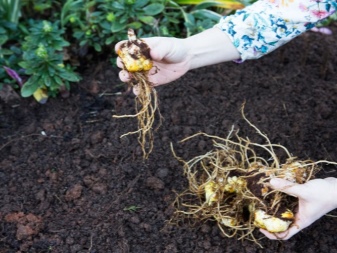
How to take care of it properly?
The agrotechnology of caring for lilies is not particularly difficult, since only some varieties are distinguished by increased requirements. To grow a crop at home, you only need to provide it with watering, pruning and fertilizing.
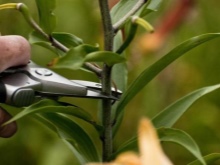
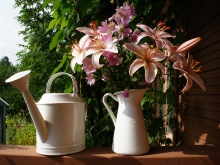
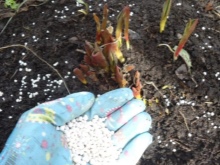
Top dressing
To grow a lily efficiently, you cannot do without top dressing. The first, intended for growth, is carried out in the spring months after the shoots have emerged. During the flowering period, lilies love supplements with potassium and phosphorus.



Watering
While the lily is growing green mass, it needs abundant irrigation. Nevertheless, it is important not to overflow, since the flower reacts extremely negatively to dampness. In summer, it is necessary to water the plant every 2 days in the morning and in the evening and do not forget about additional mulching.that helps to retain moisture. The crop also responds positively to spraying.
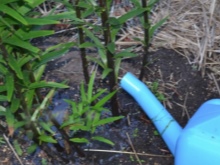
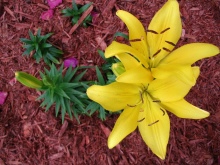
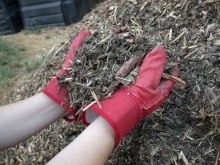
Pruning
Special pruning is not required for lilies, but in the middle of autumn all those shoots on which the buds have bloomed should be removed. But sufficient attention should be paid to preparing for wintering, especially in the case of hybrid oriental varieties... The seeds are harvested after the lily has faded and some time has passed.

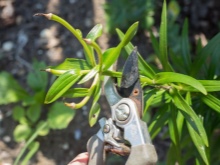
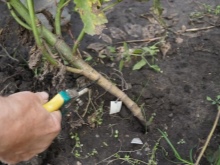
Reproduction methods
Lilies reproduce very successfully at home. To solve this problem, gardeners prefer one of the vegetative methods, which are simple and affordable. The simplest solution is to divide the bulbous nest. Every year, young bulbs are formed at the bottom of the bulb, which after 3-4 years form a full-fledged nest, combining 4-6 elements. All of these onions are to be separated in the first weeks of autumn and moved to a new location.
Some gardeners, however, carry out division and planting in the spring. Lilies born out of the nest require regular irrigation and fertilization. If you provide quality care, then in the third season of habitation, the flowers will begin to show themselves in full force.



The second variation of culture reproduction is the separation and further planting of baby bulbs. Formations that appear on the stem, but already underground, are separated in the first days of autumn, without affecting the mother bulb.
Having dug up the children, they will immediately need to be transplanted into the holes, the depth of which is 4-5 centimeters. You should not place them right away in a common flower bed - they are recommended to spend the first year in a separate area with light and nutrient-rich soil. When using this breeding method, the lily opens its buds in the third or fourth year of its existence. If the plant blooms earlier, then it is better to stop the process and remove the buds, since it has not yet accumulated enough strength.
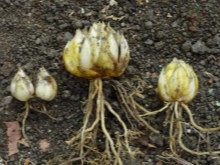

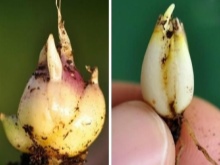
The next breeding method involves the use of scales. This method allows you to get new plants as quickly as possible and on a very large scale. The use of only one bulb makes it possible for 150 new ones to appear, since most varieties are able to form them even on a fragment of a scale.
Although this method can be applied throughout the year, it is still better to carry out the operation either in March, or during an autumn transplant or digging. The onion is taken out of the ground, washed and very carefully freed from the scales. Experts recommend not to forget that the highest quality pieces are those that are large and located in the outer layer.
If it is important for gardeners to preserve the mother bulb, then at least half of all the scales are best left. After cleaning, it can be returned back to the ground, and after a while the development of the lily will return to normal. The resulting scales are washed, kept for a quarter of an hour in a solution of potassium permanganate and dried a little. Further, all the pieces are removed into a regular plastic bag and covered with charcoal, crushed to a powder state. The bag is carefully tied and put away for six weeks in a room with a temperature of 22 to 25 degrees.
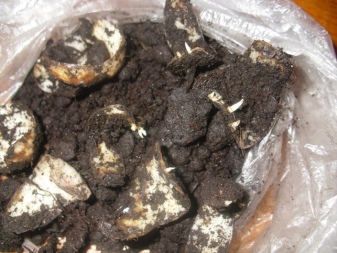
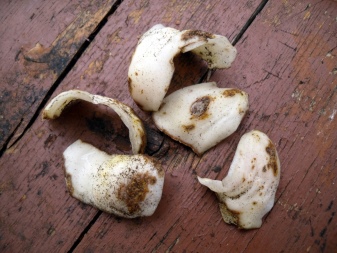
The next month, the scales will have to be held at a low temperature - from 17 to 18 degrees, and all the other days, until direct planting, it is kept in a refrigerator at a temperature of 2-4 degrees. If such a scheme seems too complicated, then you can leave the scales at room temperature until the bulbs and roots are formed, and then either put them in the refrigerator or immediately place them in a container filled with an enriched soil mixture. Planting is carried out in such a way that the scales are two-thirds of their size in the ground. In open ground, the material can be transferred in May with existing bulbs. If the scales are separated in the spring, then they are immediately transferred to open ground. The buds will bloom only in the third year of stay in the same habitat.
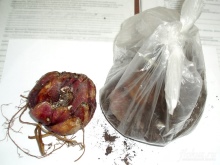

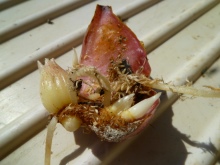
It is easy and convenient to obtain lilies from stem bulbs, but it is possible only in the case of some varieties, mainly Asian hybrids. The number and size of shoots required will depend on many factors. For example, young lilies or those that produce elongated buds will be much larger in size. In order to stimulate the formation of these air bulbs, it is necessary to provide the culture with the required agricultural technology, as well as create increased humidity. If done correctly, roots can begin to form right on the stem.
The bulbs are harvested after the lily has faded. The lesions are placed in a regular bag and refrigerated for about 14 days. When root shoots appear, the bulbs can be planted in open ground to grow. The soil should be light and nutritious, and planting should be carried out in grooves with a depth of 2 to 3 centimeters. In addition, between the individual bulbs, it is necessary to leave from 5 to 6 centimeters. The next year, the lilies are transplanted to the rest of the flowers, and in the third year they themselves will open the buds.
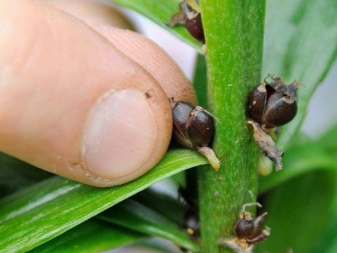
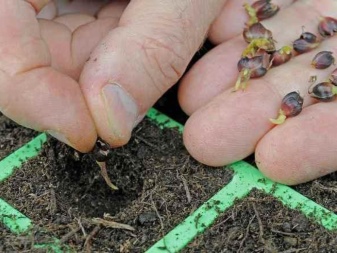
Cutting is more appropriate in a situation where the variety is especially valuable, and the source material is not enough. By the way, you can use both leaves and stems. Work with stem cuttings begins before the buds appear. Each stem is cut into several parts, the length of which is from 7 to 8 centimeters, after which each is planted in open ground with light soil. The cuttings are set slightly obliquely with a depression reaching up to the upper leaves.
Freshly planted lilies require the obligatory shade. They will also have to be watered, and after 50 days bulbs can be expected to appear. A leaf stalk is created from a leaf and a stem fragment, moreover, their separation is carried out before the flowering of the culture.
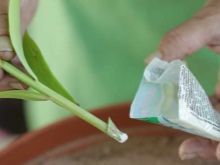
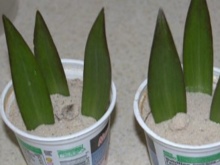
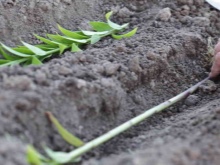
Planting is best done first in individual boxes with light soil, covered with foil. To stimulate rooting, only light irrigation is required, and results can be expected in a maximum of a month. At this time, the film is removed, and soon the lilies are allowed to be planted in open ground.

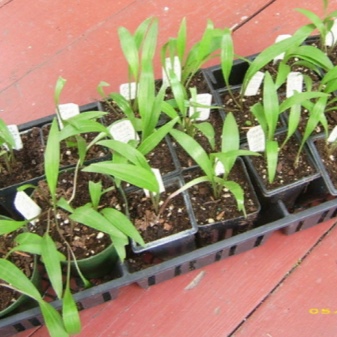
Digging and storing the bulbs
It is recommended not to leave bulbs of some varieties in the soil for the winter, since low temperatures have a detrimental effect on them. They have to be removed and stored. The place where the bulbs will spend time until spring should not be too dry to avoid wrinkling, but not too wet, which contributes to germination or the appearance of mold. It is important that the room is cool, but not below zero, in addition, the bulbs require background ventilation. After the specimens are removed to the surface, they are dried and cleaned of clods of dirt and soil.
A wooden box, a regular bag or a cardboard box is filled with peat, on which the bulbs are laid out, followed by another layer of peat and again the bulbs. The container, which is two-thirds full, is put away for storage. From time to time, the planting material must be checked, sprayed with water or wiped with a solution of potassium permanganate from mold.
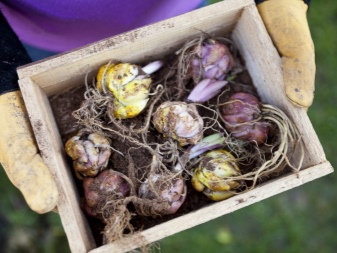
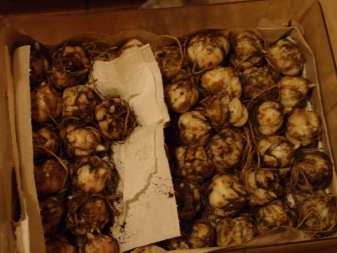
Diseases and pests
Unfortunately, there are a large number of diseases and insects that can even kill lilies. First of all, we are talking about fungal diseases: gray rot, blue mold, phytium, fusarium, rust and others. The problem is provoked either by excessive humidity, or by disturbed agricultural technology. The defeat occurs over the entire surface, starting from the bulbs, ending with the petals. It will be possible to determine the presence of a fungal disease if you carefully examine the lily.
The appearance of plaque on the bulbs and stains with mucus on the rest of the plant indicates a problem. In addition, due to excess moisture, the bulbs rot.Fungicides used to spray and damage damaged parts can help in this situation. As a preventive measure, it is enough to provide the lilies with proper care and avoid excessive moisture.
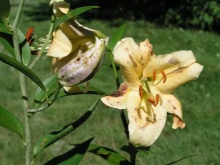
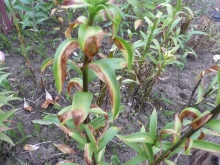
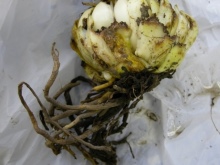
In addition, a number of viral diseases also cause problems for lilies. In this case, we are talking about tobacco and cucumber mosaics, rosette disease and tulip variegation virus. In most cases, they are caused by pests, mainly aphids, or the use of contaminated tools. The problem is identified by the state of the leaves and stems - they turn yellow, deformed, or become covered with pigment spots. Often the lily simply stops further development.
To cure a flower, you will first need to cut and destroy the affected parts of the bush, spray everything with an appropriate preparation, and then disinfect the equipment. Of the pests, lilies are attacked by almost 15 different types of insects, each of which attacks a specific part of the plant. For example, a spider mite drinks juice, a linear fly spoils the buds, a bear and an onion fly harm the bulbs, and the squeak beetle, along with the larvae, eat the leaves. Moreover, many of the pests carry viral diseases. For the fight, insecticides are always used, which become a countermeasure against this or that insect. In some cases, it will additionally require digging the soil and destroying the larvae.


The lily is sometimes attacked by small mammals like mice and rats, and moles often accidentally damage the rhizomes of plants. To combat them, you will have to use traps, mouse traps and similar devices, and also not to use straw for winter shelter, since it is it that becomes a refuge for a large number of rodents.
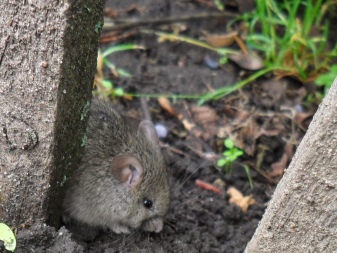
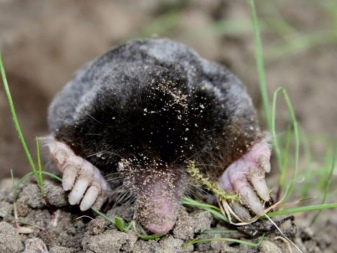
Possible problems
If lilies do not tolerate wintering well, then the reason may be an excessively damp autumn with an abundance of rain. In its natural habitat, culture develops well if spring and summer are wet enough, and autumn and winter, on the contrary, are dry enough, therefore, the inconsistency of the usual environment can negatively affect its condition. To prevent plant decay and ensure wintering in dry land, it is recommended to protect flowers with a special film during rains. If the lily did not bloom for long, and its buds quickly dried up, then the wrong choice of a site for planting may be to blame. When the plant is in the lowland, it begins to react poorly to excessively moist soil and stagnant moisture in the roots.
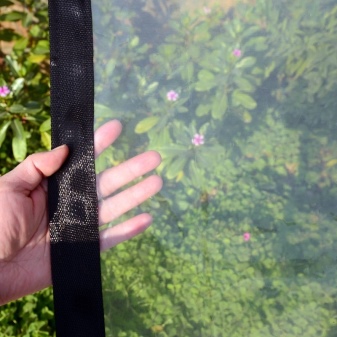
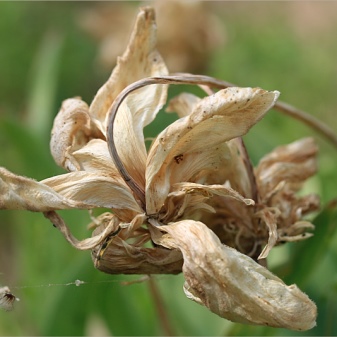
Sometimes the same situation occurs due to the overheated surface of the earth. As a preventive measure, it is required to mulch the root circle using reflective components, for example, straw, sawdust or cut grass. It happens that the bush is covered with brown leaves or it often gets sick due to the fact that manure is used as fertilizer. The presence of pathogenic microflora negatively affects the development of lilies, which cannot tolerate organic additives at all.
If the flowers did not sprout in the spring, then the bulbs may have been eaten by rodents. Another reason is freezing, since not all varieties are able to survive the cold without shelter. However, this may turn out to be the specificity of the variety, since in some lilies the sprouts do not develop at the same time.
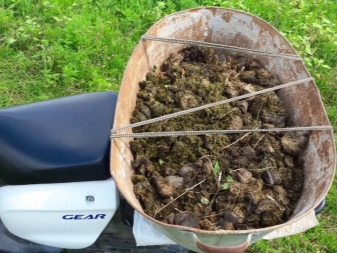

Tips for Beginners
Novice gardeners should follow a few simple rules to grow any variety of lilies in the garden. Although moisture is needed throughout the growing season of the plant, especially in June and July, you should not overdo it and bring the soil wet. Irrigation is carried out either in the morning or in the afternoon, moreover, water must be poured at the root. Another important tip is to remove the buds of first-year lilies before they open.Thus, the plant will be able to grow stronger and bloom profusely next year. In addition, you should always remove wilted buds that interfere with the development of new ones.
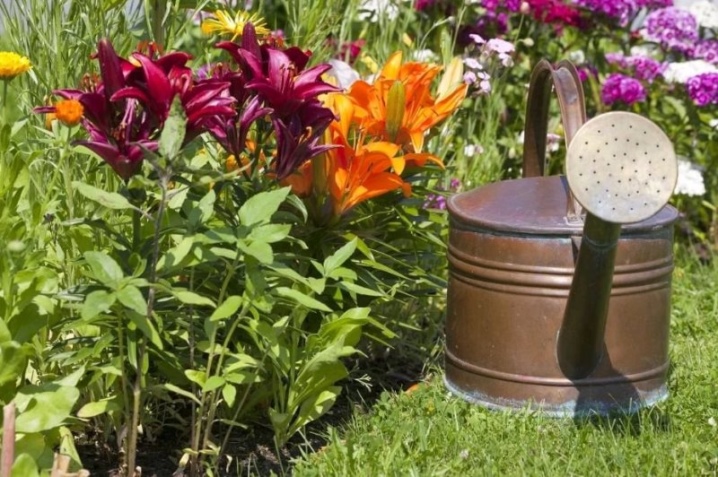
Site design options
In landscape design, the main task when planting lilies is their harmonious combination with the "neighbors" in the flowerbed. It is important to consider how chic flowers will look in combination with other flowers, shrubs, trees and even decorative elements. It is best to place the most beautiful lilies on a rather calm background of monochromatic shrubs and evergreen crops. When composing a composition, experts recommend not only tracking how the individual elements are visually combined in color and size, but also taking into account the peculiarities of the flowering period, care and planting requirements. It looks very nice when flowers of different varieties are selected and planted in two or three tiers that form an array. Low-growing varieties, such as Asian ones, are usually placed in front.


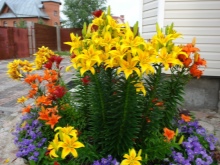
For information on how to plant lilies in spring, see the next video.







































































































The comment was sent successfully.